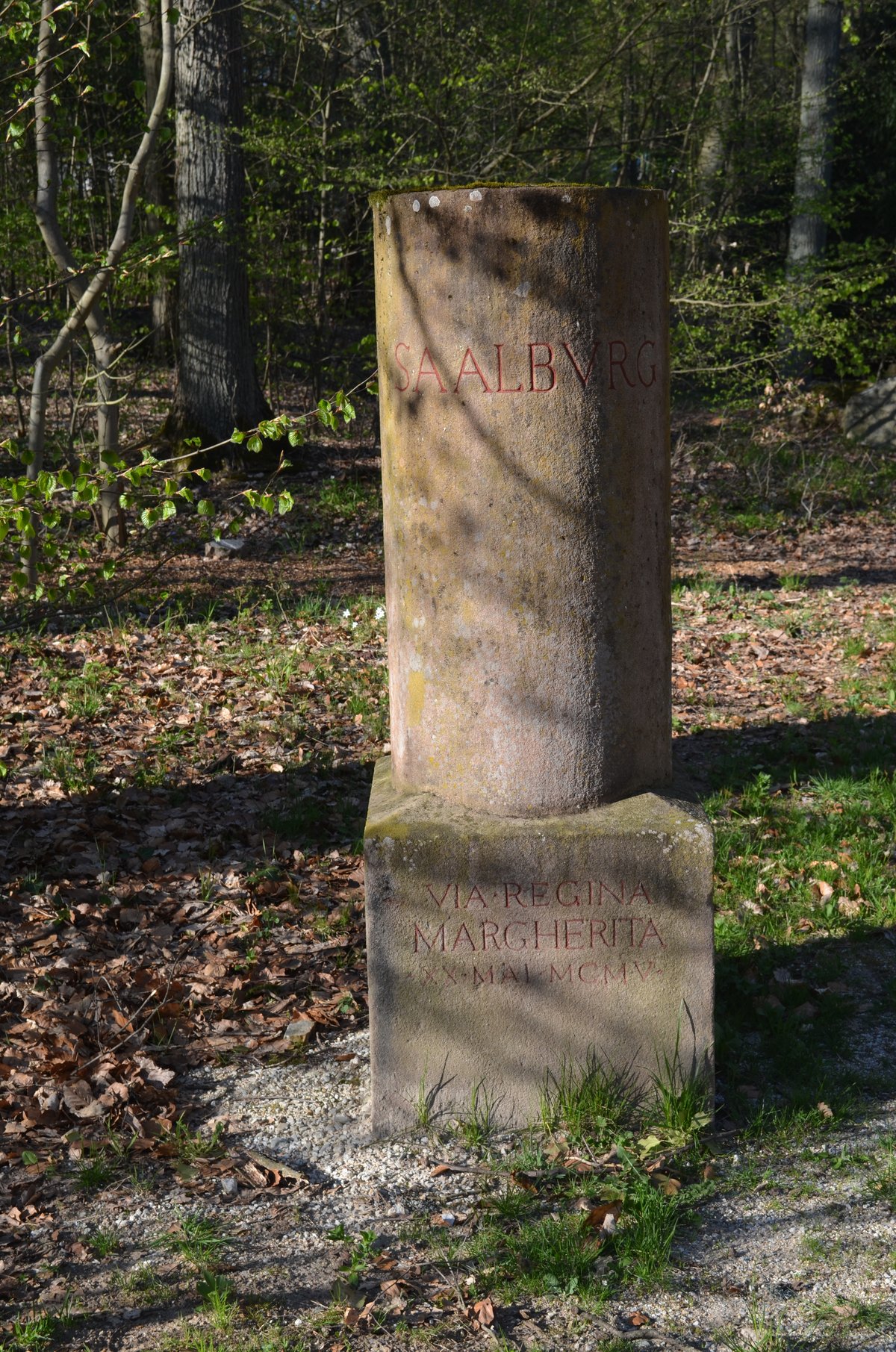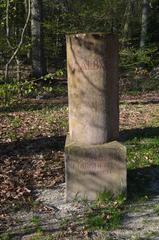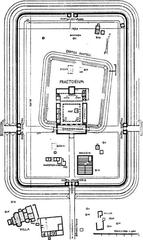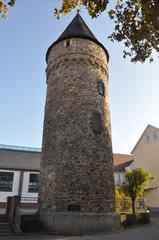
Saalburg Roman Fort: Comprehensive Visitor Guide for Bad Homburg’s Premier Historical Site
Date: 14/06/2025
Introduction: Saalburg Roman Fort and Its Historical Legacy
The Saalburg Roman Fort, perched on the Taunus ridge near Bad Homburg vor der Höhe in Hesse, Germany, is an exceptional reconstructed Roman military outpost and a gateway to the ancient Limes Germanicus—the Roman Empire’s northern frontier. Established around 90 AD under Emperor Domitian, and later expanded under Emperor Hadrian, Saalburg originally functioned as a crucial defensive and administrative center. Today, it is the world’s only fully reconstructed Roman fort along the Limes, offering visitors an unparalleled journey into the Roman world through immersive museums, reenactments, and archaeological displays. Its UNESCO World Heritage status testifies to its global cultural and historical significance (GermanSights; Saalburg Museum Official Site; SpottingHistory).
Table of Contents
- Roman Origins and Strategic Purpose
- Life at the Fort: Military and Civilian Community
- Architectural Features and Defensive Structures
- The Limes Germanicus and Saalburg’s Role
- Rediscovery, Archaeology, and Reconstruction
- UNESCO World Heritage and Modern Significance
- Planning Your Visit: Practical Information
- Interactive and Visual Resources
- Frequently Asked Questions (FAQ)
- Conclusion
- References and Useful Links
Roman Origins and Strategic Purpose
Saalburg Roman Fort was founded around 90 AD, initially as a wooden structure to house a Roman garrison responsible for guarding the Limes Germanicus. Its strategic location along the Limes Way enabled the Romans to control movement, monitor trade, and defend the frontier from Germanic incursions. By the 2nd century AD, the fort was reconstructed in stone to accommodate around 600 soldiers, reflecting its growing importance as an administrative and military hub (GermanSights; SpottingHistory).
Life at the Fort: Military and Civilian Community
Saalburg was not just a military installation—it was the nucleus of a thriving community. A civilian settlement (vicus) surrounded the fort, home to families of soldiers, artisans, traders, and service providers. The population at its height was estimated at around 2,000. Amenities included bathhouses, temples, shops, and guesthouses, while archaeological finds—ranging from coins to jewelry and daily tools—reveal the vibrant daily life of both soldiers and civilians (TravelTeening; TravelTriangle).
Architectural Features and Defensive Structures
The fort’s architecture exemplifies Roman military design, featuring:
- Four monumental gates (including the iconic Porta Praetoria)
- Stone curtain walls and wooden towers
- Defensive ditches (fossa)
- Principia (headquarters with assembly hall and shrine)
- Praetorium (commander’s quarters, now museum offices)
- Horreum (granary, now an exhibition space)
- Barracks (centuriae) and workshops (fabrica)
- Aedes (regimental shrine)
The reconstructed buildings, based on archaeological findings and historical records, allow visitors to step directly into the past (Saalburg Museum Official Site; Kultur in Hessen).
The Limes Germanicus and Saalburg’s Role
Saalburg was a critical component of the Limes Germanicus, a 550-kilometer-long border system stretching from the Rhine to the Danube. The fort helped regulate movement and deter incursions for nearly two centuries until the mid-3rd century, when the Roman Empire’s frontier collapsed under external pressures (SpottingHistory).
Rediscovery, Archaeology, and Reconstruction
Systematic archaeological excavations began in the 19th century, culminating in Kaiser Wilhelm II’s order for the fort’s meticulous reconstruction from 1897 onwards. Today, Saalburg serves as an open-air museum, research center, and educational hub, preserving and interpreting Roman heritage for new generations (GermanSights; TravelTriangle; Kultur in Hessen).
UNESCO World Heritage and Modern Significance
In 2005, Saalburg was inscribed as part of the “Frontiers of the Roman Empire” UNESCO World Heritage Site. This designation recognizes its outstanding preservation, educational value, and role in illustrating the reach and ingenuity of Roman civilization (TravelTriangle). The fort frequently hosts reenactments, craft demonstrations, and family-friendly events that bring ancient history vividly to life.
Planning Your Visit: Practical Information
Visiting Hours and Seasonal Variations
- March–October: Tuesday to Sunday, 10:00 am–6:00 pm
- November–February: Tuesday to Sunday, 10:00 am–4:00 pm (reduced hours)
- Closed Mondays (except public holidays in Hesse), and December 24th & 31st
Always check the official website for up-to-date information.
Ticket Prices and Admission
- Adults: €8
- Reduced (pensioners, students, people with disabilities): €6
- Children/Teens (6–17 years): €3
- Children under 6: Free
- Family Ticket (2 adults + children up to 17): €16
- Small Family Ticket (1 adult + children up to 17): €8
- Combined tickets (with the Celtic World at Glauberg) and group rates are available
- Dogs (on leash): €1
Payment by EC card or cash; credit cards are not accepted (Saalburg Museum).
Accessibility and Facilities
- Most main areas are wheelchair accessible; some outdoor paths and archaeological zones may have uneven surfaces.
- Restrooms, drinking water stations, and shaded seating areas are provided.
- Lockers, a museum shop, and on-site parking are available.
- Dogs are permitted with a fee and must remain on a leash.
Guided Tours and Educational Programs
- Guided tours (in German and English, 60–90 minutes) cover the fort’s history, architecture, and daily life. Group tours (20+ people) should be booked in advance (Saalburg Guided Tours).
- Thematic tours focus on Roman religion, military technology, or social life.
- Educational workshops and school programs offer interactive learning and hands-on activities.
- Audio guides and printed materials are available in several languages.
Dining and Site Amenities
- The Taberna restaurant serves Roman-inspired and German cuisine. Popular dishes include moretum (herb cheese), Roman lentil stew, honey cakes, and spiced wine (Taberna Menu).
- The museum shop features books, replica artifacts, and educational games.
Directions and Transportation
- By Public Transport: S-Bahn line 5 from Frankfurt am Main to Bad Homburg, then city bus 5 to Saalburg (limited service); or use the Taunusbahn (Line 15) to Saalburg/Lochmühle station, then a 45-minute walk.
- By Car: Am Römerkastell 1, 61350 Bad Homburg vor der Höhe. Parking is ample (OpenStreetMap).
- Accessibility: Barrier-free access is available for most areas; download detailed maps from the museum website.
Nearby Attractions
- Celtic World at Glauberg: Explore regional pre-Roman history with a combined ticket.
- Taunus Nature Park: Hiking and cycling in the scenic forest.
- Bad Homburg Town Center: Spa gardens, historic architecture, and dining (Bad Homburg Tourism).
Interactive and Visual Resources
- Virtual tours and interactive maps: Saalburg Virtual Tour
- Photo galleries with alt text optimized for “Saalburg Roman Fort visiting hours,” “Saalburg tickets,” and “Bad Homburg historical sites”
- Event calendars and educational downloads are available online (Event Calendar).
Frequently Asked Questions (FAQ)
Q: What are the current Saalburg Roman Fort visiting hours?
A: Generally, Tuesday–Sunday, 10:00–18:00 (March–October) and 10:00–16:00 (November–February). Closed Mondays except public holidays.
Q: How much do tickets cost?
A: Adult tickets are €8; discounts for students, seniors, families, and combined tickets are available.
Q: Is Saalburg wheelchair accessible?
A: Most main areas are accessible, but some reconstructed outdoor zones may be uneven.
Q: Are guided tours available?
A: Yes, for groups (advance booking required), as well as thematic tours, audio guides, and educational workshops.
Q: Can I bring my dog?
A: Yes, dogs are allowed on a leash for a small fee.
Q: Is credit card payment accepted?
A: No; payment is by EC card or cash only.
Conclusion
Saalburg Roman Fort is a unique intersection of history, culture, and education—a place where the ancient world comes alive through reconstructed architecture, hands-on exhibits, and vibrant reenactment events. Whether you are a history buff, educator, family, or traveler, Saalburg offers a captivating and accessible experience set amid the beautiful Taunus landscape. For the latest Saalburg Roman Fort visiting hours, ticket prices, and event updates, consult the official Saalburg Museum website. Download the Audiala app for audio tours and follow Saalburg on social media to enhance your visit and stay connected with ongoing historical celebrations.
References and Useful Links for Saalburg Roman Fort
- GermanSights: Saalburg Roman Fort Visiting Hours, Tickets, and History in Bad Homburg, 2025
- Saalburg Museum Official Site: Visiting Hours, Tickets, and What to See in This Bad Homburg Historical Site, 2025
- Saalburg Museum: Visitor Guide, 2025
- Kultur in Hessen: Cultural and Educational Insights, 2025
- SpottingHistory: Saalburg Roman Fort Overview
- TravelTeening: Exploring Saalburg Roman Fort
- TravelTriangle: Guide to Saalburg Roman Fort
- OpenStreetMap: Directions to Saalburg Roman Fort
- Bad Homburg Tourism



